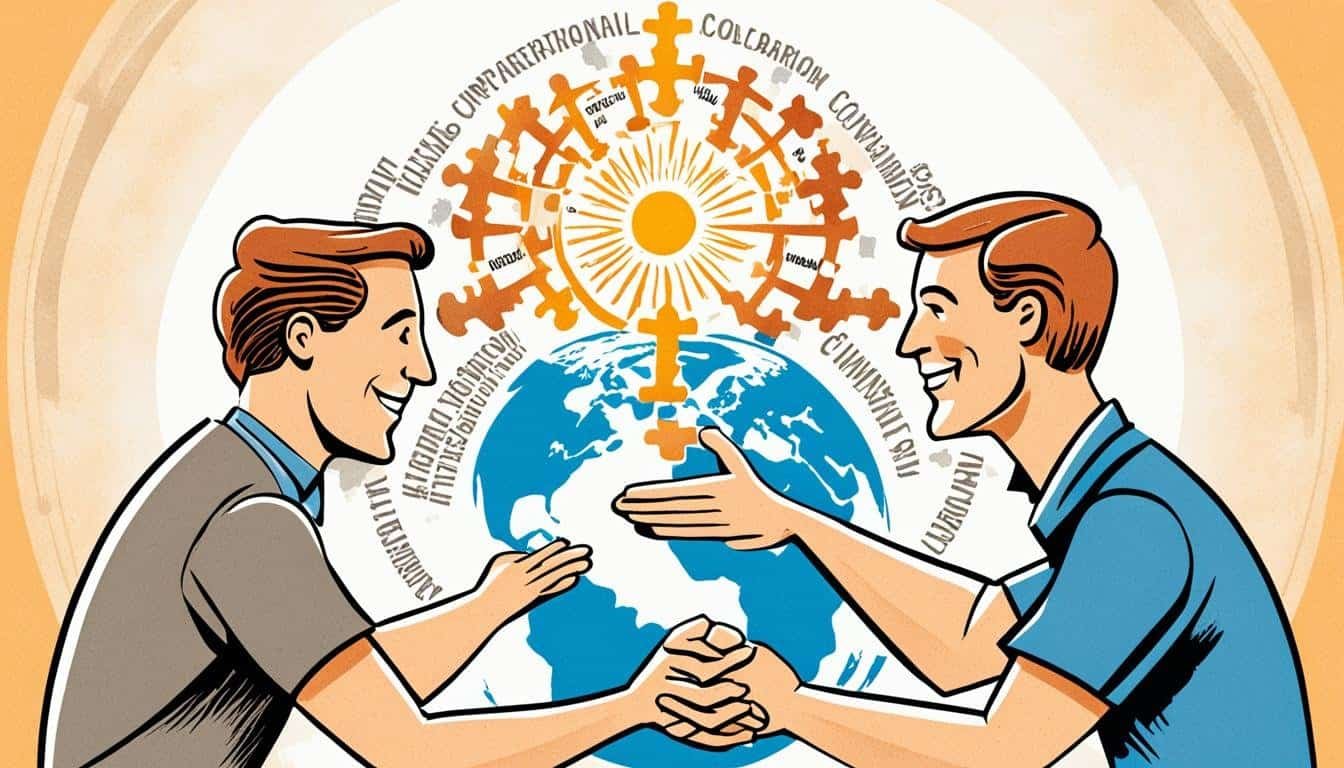Effective International Conflict Resolution Techniques
“You can’t change what’s going on around you until you start changing what’s going on within you.” — Tony Blair
Resolving international conflicts needs a smart approach. It’s about finding value in unexpected places. Tony Blair, the former Prime Minister of Great Britain, said that changing from within is key. He stressed the need for trust in talks and facing past issues honestly.
In the world of international talks, solving conflicts and building peace is vital. These efforts often use empathetic talks, keeping things private, and speaking softly. Skilled mediators who know how to communicate across cultures are also key. Success stories like Nelson Mandela and peace deals like the Camp David Accords show how this works.
Key Takeaways
- Emphasizing internal transformation can facilitate effective conflict resolution.
- Building trust is crucial in international negotiations.
- Successful conflict resolution strategies often address underlying symbolic issues.
- Empathetic and skilled negotiators play a critical role in mediation.
- Historical examples like the Camp David Accords offer valuable insights into peacebuilding techniques.
Importance of International Conflict Resolution
International conflict resolution is key to global peace and economic stability. It helps manage disputes well, leading to stronger cooperation among nations. This is vital for a peaceful world.
Impact on Global Relations
International conflict resolution greatly affects global relations. It leads to better cooperation, lowers war risks, and builds strong ties between countries. Studies show that 45% of all conflicts from 1816-1986 were between long-time rivals. Good conflict resolution can reduce these deep-seated issues and improve diplomatic ties.
Economic Consequences
Not solving conflicts harms the economy by affecting markets and trade. These disputes use resources on conflict, not development, causing big economic problems. For example, the Greece-Turkey conflict from 1955-1988 needed 91 efforts to manage. Solving conflicts well uses resources for growth, boosting the economy and helping it grow.
Humanitarian Considerations
Humanitarian aid and conflict resolution go hand in hand. Long conflicts worsen human rights and block aid efforts. Quickly solving conflicts is key to stop more suffering and make sure aid gets to those who need it. International groups and efforts in peacebuilding help achieve humanitarian goals better.
In conclusion, solving international conflicts does more than just keep the peace. It helps build a stable economy and supports humanitarian aid. This leads to a better, prosperous world for all future generations.
Common Challenges in Global Conflict Resolution
In the world of international diplomacy, solving global conflicts is tough. Two big hurdles are cultural and language differences, and deep mistrust in negotiations.
Cultural and Language Barriers
One big negotiation barrier is cultural and language differences. These can cause misunderstandings that slow down talks. For example, if people don’t get each other’s cultural ways or can’t speak the same language, talks can break down.
This makes it hard to find common ground. The 52-year war in Colombia, which caused over 220,000 deaths and displaced seven million people, shows how crucial it is to get past these barriers. Good international diplomacy means finding ways to understand and work together despite these differences.
Distrust and Mistrust
Mistrust in negotiations is a big problem. Many people are hesitant to give in because they worry they’ll be taken for a ride. This fear can really slow things down, making everyone wary and unsure.
Leaders like Nelson Mandela showed how to build trust even when it seemed impossible. This shows that trust is key to solving conflicts.
Former British Prime Minister Tony Blair talked about not judging small losses too harshly in big conflicts. He said leaders need to keep trust while dealing with tough negotiations.
To solve conflicts, it’s important to improve communication between cultures and build trust. By tackling these issues, diplomats and negotiators can move closer to lasting peace and solutions.
Role of Diplomacy in Resolving International Disputes
Diplomacy is key in solving international problems. It uses diplomatic skills to handle complex conflicts. By acting early, it can stop conflicts before they turn violent. This protects human rights and keeps the peace.
Historical Examples of Successful Diplomacy
History shows how diplomacy has helped end wars and bring peace. For example, the Camp David Accords in 1978 helped Egypt and Israel make peace. The Northern Ireland Peace Process also shows how careful diplomacy can solve long-standing issues.
Skills Required for Effective Diplomacy
Being a good diplomat needs special skills. You need empathy and good communication to understand different views. Knowing about cultures and politics helps diplomats work well with others.
Handling global issues like climate change or cybersecurity also requires working together with many countries. Building trust is key to solving conflicts. Even with limited budgets and safety worries, skilled diplomats are crucial for world peace.
Peacebuilding Techniques for Long-Term Resolution
Keeping peace for the long run means using strategies like getting communities involved and making sure everyone is included. These methods tackle conflicts at the ground level, aiming for lasting solutions rather than quick fixes. It’s key to involve people directly affected by the conflict in peacebuilding efforts.
Community Engagement and Inclusion
Getting communities to take part in solving their own problems helps make sure everyone’s voice is heard. This way, conflicts don’t come back because people understand and work together. Groups like Zebras Unite show how local efforts can lead to a fairer and more peaceful world.
Studies from places like Colombia, Sierra Leone, and Northern Ireland show that making peace means balancing justice with healing. Experts like Eileen F. Babbitt from Tufts University believe in the power of reconciliation to build lasting peace. When communities are part of the healing process, the solutions are stronger and more complete.
The Art of Negotiation in International Conflicts
Effective negotiation in international conflicts is all about building trust and understanding. It’s a mix of art and science. The goal is to solve problems without giving up what’s important to each side.
Building Trust and Understanding
Building trust is key in international negotiations. When trust is built, everyone feels safe to share their true needs and worries. Starting open talks, showing fairness, and respecting different cultures helps everyone understand each other better.
Strategies for Effective Negotiation
Here are some strategies to improve negotiations in international conflicts:
- Active Listening: This means really getting what the other side wants. It can help find common ground and solutions.
- Patience: It’s crucial to understand everyone’s needs and manage crises well. Waiting can change how people see things and help them work together better.
- Emotion Management: Keeping emotions in check is vital. Taking a break can help you calm down and stop things from getting worse.
- Collaboration: Working together can create value for everyone. It shifts the focus from winning to finding solutions that benefit all.
- Flexibility in Strategy: Being able to change your approach helps you handle new challenges and solve problems as they come.
Using these strategies, negotiators can not just solve disputes but also build strong and successful partnerships. Keeping the focus on understanding each other is key to successful negotiations.
Conflict Resolution Mediation: A Key Approach
Mediation is key in solving international disputes. It uses third-party negotiators to help talk and find common ground. This method has a success rate of about 60 percent, showing it’s a powerful way to settle conflicts.
Studies by Jacob Bercovitch show mediation works well in long-standing conflicts. When both sides want peace, mediation can help. Experts like conflict researchers and Quaker mediators bring a neutral view to the table.
States and organizations like the United Nations often lead mediation efforts. They use their resources and influence to help settle disputes. For mediation to work, three things are crucial: both sides must want to settle, the time is right, and there’s a good mediator.
A good mediator needs smarts, tact, and the ability to draft proposals. A sense of humor and deep knowledge of the conflict also help. High-level mediators tend to get better results.
Mediators can come into a conflict by being asked or appointed by a higher authority. They work to build trust, teach about mediation, and get everyone on board. Gathering data and analyzing the conflict is key to understanding it well. Then, a plan is made to guide the parties towards peace.
Places like London, Paris, Singapore, and New York are centers for mediation. The way mediation works can vary by region. Europe focuses on helping parties talk, while Asia looks at the bigger picture. The West values direct communication, while the East emphasizes harmony.
In conclusion, mediation is a powerful tool for solving conflicts worldwide. With skilled mediators and negotiators, it offers a way to resolve disputes. Tailoring mediation to local cultures makes it even more effective in bringing lasting peace.
Cross-Cultural Conflict Management Strategies
In the complex world of international disputes, knowing about cultural differences is key. Cross-cultural negotiation needs a deep understanding of cultural sensitivity. It also requires navigating the small details that prevent misunderstandings.
Understanding Cultural Differences
Knowing about cultural differences is vital for managing conflicts. In global settings, deals often don’t do as well as they do within one culture. This is because of stereotypes leading to wrong expectations and misunderstandings.
Using cultural prototypes in negotiation helps by focusing on averages, not strict stereotypes. For example, in the U.S., people value quick negotiations. In India, building relationships comes first. These differences show why cultural sensitivity is key to avoiding biases and creating harmony.
Implementing Cross-Cultural Training
It’s important to have thorough cross-cultural training to clear up confusion and lower conflicts. Companies that invest in teaching how to manage conflicts see a big drop in stereotypes and biases. This leads to a more respectful workplace.
Using professional interpreters in solving conflicts makes things clearer by over 70%. This ensures everyone understands each other. Having clear policies and encouraging teamwork in diverse teams cuts down on conflicts by 45%.
Training in cultural awareness and sensitivity boosts employee happiness by up to 40% in diverse teams. This shows how valuing diversity helps in cross-cultural negotiations.
Good conflict management training and a focus on cultural sensitivity can greatly improve international negotiations. It helps create a more inclusive and peaceful global environment.
Case Studies: Effective International Conflict Resolution Techniques
Looking at international conflict case studies gives us key insights into solving global disputes. Peace treaties like the Camp David Accords and the Northern Ireland Peace Process show how diplomacy and smart negotiation can change things.
Camp David Accords
In 1978, U.S. President Jimmy Carter mediated the Camp David Accords. This peace deal was between Egyptian President Anwar Sadat and Israeli Prime Minister Menachem Begin. They worked out agreements to end their long-standing conflicts.
This shows how steady diplomacy and listening to everyone involved can lead to peace.
Northern Ireland Peace Process
The Northern Ireland Peace Process, ending in the 1998 Good Friday Agreement, is another great example. Senator George Mitchell was key, pushing for open talks, non-violence, and democracy. His efforts helped end the fight between unionists and nationalists.
This shows the power of working together and talking things out. It proves that with patience and smart planning, we can make peace last.
These examples prove that careful study and comparison can help solve big conflicts. By looking at these historical talks, we see that diplomacy is key to lasting peace.
Building Trust in International Negotiations
Trust is key in international talks. It’s not just about being open and honest. It’s also about being accountable and using strategies like apology diplomacy. By focusing on credibility, parties can start a productive conversation and understand each other better.
Establishing Credibility
Building trust can be done in several ways. Getting references from trusted third parties is important. These references help show that negotiators are reliable and trustworthy.
Also, making unilateral concessions shows you’re friendly and open to working together. It’s important to clearly explain these concessions to avoid confusion and build trust.
Listening well, especially when there’s a language barrier, can really help in negotiations. Using neutral terms can also make things clearer and reduce disagreements.
The Role of Apologies and Amends
Apology diplomacy is vital for fixing conflicts. Saying sorry can show you’re truly remorseful and help rebuild trust. It sets the stage for constructive talks.
Apologizing for past wrongs and making sure they don’t happen again is key. Explaining your actions can also clear up misunderstandings and build trust. For example, explaining your demands can help avoid confusion and create a team spirit.
Building trust in international politics takes time and effort. It’s about seeing conflict as a journey, not just a quick fix. It means really listening to both sides and being willing to make tough choices for the greater good.
Lessons from Historical Conflict Resolution Examples
Looking at past conflicts helps us learn how to negotiate better. These examples teach us historical lessons in negotiation that we can use today. They show us how to handle complex global issues.
Nelson Mandela’s Negotiations
Nelson Mandela showed us the value of empathy, patience, and smart planning. He worked with South African President F.W. de Klerk, building respect and understanding. This led to ending apartheid and creating a democratic South Africa.
Mandela also stressed the need for conflict resolution education. He believed in the power of dialogue and understanding. His story shows how connecting on a personal level and strong leadership can solve deep conflicts.
Nuclear Nonproliferation Efforts
Negotiations to stop the spread of nuclear weapons have been key to keeping the world safe. The Nunn-Lugar Cooperative Threat Reduction Program is a great example. It has destroyed over 7,500 nuclear warheads and more than 1,400 missiles in 20 years.
Laura Rockwood led successful talks between the U.S., Russia, and the IAEA. She built trust by listening and understanding their concerns. This led to removing dangerous materials from weapons programs since 1996. Her skills in both one-on-one and group talks are vital for today’s diplomats.
Examples of nuclear nonproliferation negotiations show us how to negotiate better. Using strategic thinking, choosing the right people, and private talks can greatly improve diplomatic results. These lessons help us work towards global peace and security today.
Conclusion
Understanding how to solve global conflicts is key. Using methods like mediation and culturally smart strategies helps. This leads to lasting peace and a safer world.
This article showed why solving global conflicts matters a lot. It affects how countries work together and the economy. We looked at how diplomacy, negotiation, and community involvement help. We also saw how important it is to consider different cultures.
Looking at past successes like the Camp David Accords and the Northern Ireland Peace Process shows us what works. These examples prove that with the right approach, we can solve big problems.
The secret to winning in international talks is knowing how power and peace efforts mix. Studies show that talking openly, understanding emotions, and having a plan helps solve conflicts. By using these tips, we can keep moving towards peace and cooperation around the world.
Source Links
- Five Conflict-Resolution Strategies for the Workplace
- Conflict Resolution in a Changing World | International Conflict Resolution After the Cold War
- 5 Conflict Resolution Strategies
- North Central College
- The Structure of International Conflict Management: An Analysis of the Effects of Interactability and Mediation
- The Evolution of Conflict Resolution
- international conflict resolution
- 6 Conflict Resolution Barriers You Need to Overcome
- The Role of Diplomacy in Resolving Global Conflicts
- Public Diplomacy and International Conflict Resolution: A Cautionary Case from Cold War South America
- What are Role of Diplomacy in Conflict Prevention and Resolution? | 4 Answers from Research papers
- Conflict Resolution and Peacebuilding (With Some Help From the Zebras)
- Conflict Resolution and Human Rights in Peacebuilding: Exploring the Tensions | United Nations
- 3 Negotiation Strategies for Conflict Resolution
- The Role of Negotiation in Conflict Resolution Strategies – KARRASS
- the art of negotiation
- Summary of "Mediation in International Conflict: An Overview of Theory, A Review of Practice"
- Summary of "The Mediation Process: Practical Strategies for Resolving Conflict"
- International Mediation: How Does It Really Work?
- Conflict Management in Cross-Cultural Work Environments — Conflict Resolution Consulting
- How to Resolve Cultural Conflict: Overcoming Cultural Barriers at the Negotiation Table
- Case Studies: Examples of Conflict Resolution
- Evaluating Interventions in History: The Case of International Conflict Resolution | International Conflict Resolution After the Cold War
- Case Study of Conflict Management: To Resolve Disputes and Manage Conflicts, Assume a Neutral 3rd Party Role
- Negotiation Skills: Building Trust in Negotiations
- international conflict
- Conflict Resolution Examples in History: Learning from Nuclear Disarmament
- Lessons from brain science — and history’s peacemakers — for resolving conflicts
- Summary of "International Conflict Resolution After the Cold War"
- 7 Effective Conflict Resolution Techniques In The Workplace | Wellable







